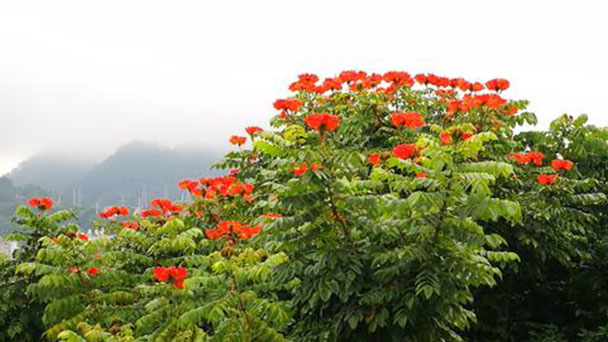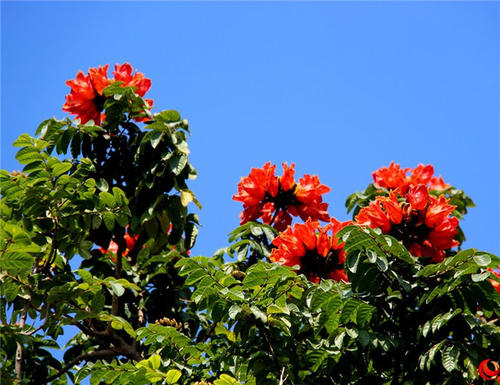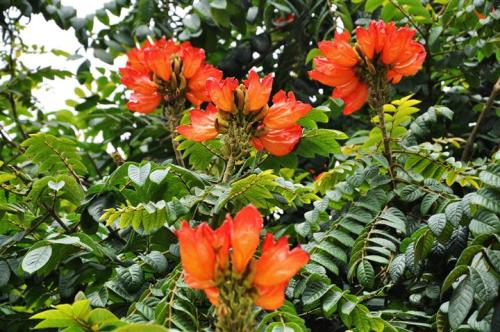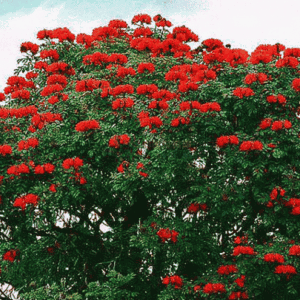African tulip tree (Spathodea campanulata) profile
Written by Maggie
Mar 04 2021

African tulip tree, scientific name Spathodea campanulata, is a large evergreen tree of Vladivoeaceae. African tulip tree is a positive plant, needs strong light, suitable temperature for growth: 23 ~ 30℃, fast growth, native to tropical Africa, now widely cultivated. It has medicinal value and high ornamental value of afforestation.
African tulip tree is native to tropical Africa, and is widely cultivated in Southeast Asia, Hawaii and other places. It is more cultivated in Taiwan area of China, and a few species are introduced in South China.Suitable for garden trees or street trees.
African tulip tree picture

Morphological characteristics of African tulip tree
African tulip tree is an evergreen tree with a height of 10-20 meters. Its trunk is straight, grayish white and easily branched. Leaves are odd pinnate compound leaves, entire, leaflets short petiolate, ovate-lanceolate or long elliptic;Inflorescences panicle or raceme, terminal, corolla campanulate, red or orange-red, single flowers ca. 10 cm.
Pinnate compound leaves of african tulip tree are opposite, with petioles up to 45 cm long; African tulip tree has 13-17 leaflets, leaves elliptic or obovate, 5-10 cm long, 3-5 cm wide. The flowers are large, clustered into a compact corymbiform raceme; Calyx is fossil-spathe, 5-10 cm long; Corolla is campanulate, enlarged on one side, 3 -- 5 cm long, 5 -- 6 cm in diam., orange-red, yellow in the center, wrinkled.
Capsule of African tulip tree is oblong prismatic, fruit petals red brown, nearly woody. Seeds have membranous wings.
African tulip trees can grow to more than 10 meters tall. Leaves are opposite, pinnate compound leaves, lobules ovate-elliptic to ovate-lanceolate, entire margin. Flowers top, panicle, flowers from the periphery of the circular inflorescence in turn, red or orange red, colorful as fire, flowering spring to early winter, the province's northern flowering, the more to the south of the longer flowering period. African tulip tree is suitable for garden trees or street trees.
Ecological habits of the African tulip tree
African tulip tree is a positive plants, need strong light.Optimum temperature for growth: 23 ~ 30℃
African tulip tree is a tropical tree with fast growth. African tulip tree has heat resistance, drought resistance, moisture resistance, poor resistance, brittle branches, wind resistance, and are easy to transplant. Cultivation with fertile and well drained sandy loam or loam soil is suitable. The tree of fire is of a strong nature and delights in the light; African tulip tree has heat resistance, drought resistance, water resistance, barren resistance, but good drainage loam or sandy loam cultivation is the best; Wind resistance, wind branches easy to break; However, it is not cold resistant, and the suitable temperature for growth is 23-30 ℃, and the normal growth and development can be achieved above 10℃.
How to grow and care for African tulip tree
Soil
African Tulip Tree is best cultivated with loose, breathable and water-discharging soil, which can be prepared with garden soil and leaf rot soil.
Light
African Tulip Tree grows enough sunlight, like the sun, so give it enough light every day, lest the light is too weak to affect its normal growth.
Temperature
Give it a growing environment of 23 ~ 30℃, and the minimum temperature should not be lower than 10℃. If the temperature is too low, African Tulip Tree will stop growing. When the temperature is too low in winter, warm measures should be taken in time to avoid frostbite.
Fertilization
African tulip trees do not have high requirements on fertilizers, but they need to ensure sufficient nutrients during its growth period. Composite or organic fertilizers are generally the main fertilizer, and thin fertilizer should be applied frequently, usually 3-5 times a year.
The propagation of the African tulip tree
African tulip tree propagation by cutting, sowing or high pressure method, all appropriate in the spring, after the seeds germinate, generally in 5-6 afternoon can be flowering. African tulip trees require higher temperatures to flower. In northern parts of South China, because of lower temperatures, they do not flower or flower less.
In the flowering season, the flowers are placed on the top of the tree canopy, like the raging water flame, and the flowers are as bright as fire, which is extremely eye-catching. African tulip tree can be used for street trees and court.

Disease control of African tulip tree
Diseases
Rhizoma blight occurs mainly in spring when there is a lot of rain, and both seedlings and adults are affected. Victimized place produces dark brown disease spots, when a serious piece dies.
Transplant with disease-free new soil and use decomposable fertilizer, never fresh farm manure.Remove the diseased plant in time.Before transplanting, use 40% formaldehyde 50 milliliters per square meter to disinfect the soil with 6 kilograms of water, or use 70% penta chloro nitrophenol to mix fine soil at a ratio of 1∶30, and sprinkle on the soil of the seedbed. Spray 70% methyl tobuzine 1000 times solution or 75% chlorothalonil 1000 times solution one week after spring seedling, spray once every 10 days, use alternately.
The main insect pests
The main insect pests of African tulip tree are aphids, foot moth, yellow night moth, pilfering night moth, large and small ground tiger and scarab beetle. Aphids can affect plant growth and induce coal stain. Leaf-eating larvae of the moth, moth of the night, can eat up all the young shoots in 2 to 3 days when serious; Ground beetles and scarab larvae eat root, ground beetles mainly harm cuttings and seedlings, scarab large, medium and small seedlings are all harmful.To control aphids, spray 5% diesel oil emulsion or Pomex 3 to 5 degree sulphur mixture before germination to kill overwintering adults and eggs. After falling flowers, spray the second time, and spray the third time between autumn and October. For the prevention and control of the larva of the moth, it is recommended to spray 50% methamidophos solution 1500 times to treat early and small. The larvae of ground tiger and beetle are underground pests. The control method is to strengthen nursery management and not to apply immature organic fertilizer.Ploughing in winter, the overwintering larvae are turned over to the surface and frozen to death. Apply 3% carbofuran granules to a depth of 10 to 20 cm in furrows at a rate of 2 kg per mu.
The distribution area of the African tulip tree
African tulip tree is originally produced in tropical Africa, and is now widely cultivated in Southeast Asia and Hawaii, with more cultivated in Taiwan of China, Southeast Asia, Hawaii, Taiwan of China and South China, where a small number of species have been introduced.
The purpose of the African tulip tree
Ornamental value
Flower African tulip trees are red in color and beautiful in shape.Landscape trees and garden trees can be appreciated, the flowering period is longer.
Garden function: African tulip tree shape is very beautiful, the whole plant into a tower or umbrella shape, elegant leaf shape, four seasons lush beautiful, gorgeous colors, rich flowers, suitable for street trees, courtyard trees, etc.In spring and summer, flowers bloom all over the tree, the color is bright red, is a quite good ornamental tree civil species.
African tulip tree is adaptable, resistant to pruning and germination, making it an advantage for hedgerows. Generally, the soil of urban greening is poor, so it is impossible to remove construction waste well. African tulip tree grows well in such a poor environment, with strong natural resistance to adversity and fewer diseases and pests. As long as you prune carefully, the hedgerows planted in the same year can be effective in the same year.
African tulip trees are also suitable for planting on slope protection. According to the author's observation, the branches of an African tulip tree allowed to develop naturally can grow to 1.2 meters in one year and about 2 meters in two years, and begin to blossom and bear fruit.
Landscape use of an African tulip tree
As a spherical arrangement, African tulip trees can be patchwork planted, cut branches, put branches and trimmed. They are planted on the lawn and dotted in the depths of the garden. The bright red fruits of African tulip trees give people a warm feeling in cold winter. The ball of African Tulip Tree is arranged on both sides of the road or in the middle green belt in a regular manner, which can also play a role in landscaping and eye-catching.
African tulip trees, as a combination of landscape woodland, can reflect the wild interest of nature.

Latest Updated
- Benefits of Bugleweed - 7 Science-backed Health Benefits
- Bugleweed Dangers & Side Effects - Is It Poisonous?
- How to Plant Evergreen Trees - What You Should Know
- When to Plant Evergreens - Grow Guide for Evergreen Trees
- 12 Wonderful Evergreen Shrubs for Your Garden
- 12 Popular Evergreen Plants with Pictures for Beginners
- When And How To Prune A Lilac Bush Like a Pro
- How to Grow & Care for Lilac Vine (Hardenbergia Violacea)
- Japanese Lilac Tree (Syringa Reticulata) Care & Propagation Guide
- Shumard Oak Pros and Cons - What to Know
Popular Articles
- Winter maintenance of Antirrhinum Majus
- How to Grow Terminalia Mantaly Tree
- How to Grow and Care for Crossostephium Chinense
- How to grow Antirrhinum Majus in spring
- Peristeria Elata (Dove Orchid) Profile: Info & Care Guide
- Underwatered Snake Plant (Sansevieria Trifasciata) - Signs And How To Fix
- How to Care for Brazilian Jasmine Plant (Mandevilla Sanderi)
- How to Grow & Care for Graptopetalum Purple Delight in Summer
- Rosa Chinensis (China Rose): Plant Growing & Care Tips
- How to Care for Baby Sun Rose (Aptenia Cordifolia)